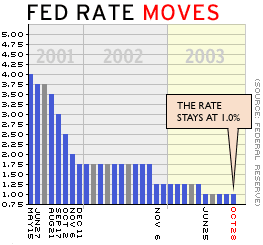NEW YORK (CNN/Money) -
The sluggish November jobs report gives the Fed plenty of cover to keep interest rates at 40-year lows but the central bank still may sound a slightly more upbeat note about the economy when its policy-makers meet Tuesday.
Alan Greenspan and company met Tuesday to discuss the economy and their target for the fed funds rate, an overnight bank lending rate that influences rates throughout the economy.
The Federal Reserve cuts the fed funds rate when it wants to spur economic growth, and boosts it to help ward off inflation. The central bank's announcement on rates is due about 2:15 p.m.
In response to a recession, terrorist attacks, the three-year bear market in stocks, two wars, corporate scandals and other nightmares, the central bank's policy-makers have slashed the fed funds rate to 1 percent, a rate not seen since 1962.
| 
| |

| 
| 
|

|
 William Ford, former president of the Federal Reserve Bank of Atlanta, talks about two essential elements to watch for in the Fed's statement, which is expected today. William Ford, former president of the Federal Reserve Bank of Atlanta, talks about two essential elements to watch for in the Fed's statement, which is expected today.
|
 Play video
Play video
(Real or Windows Media)
|
| 
|

|
|
And most economists doubt they'll raise the rate Tuesday -- especially after Friday's report from the Labor Department showing payrolls grew at a much slower pace in November than analysts had expected.
"The contained job gains will make it easier for the Fed to convince investors that it will not rush to tighten," UBS Warburg chief economist Maury Harris wrote in a research note Friday. "We still expect tightening to start only next August." Tightening means raising rates.
The weak job market has kept a lid on wage growth and helped sink core consumer price inflation to its lowest level since 1966. Though there are plenty of signs of higher prices on the horizon -- the dollar's value has been sinking, while oil, gold and plenty of other commodity prices have been rising -- most economists believe the Fed won't raise short-term rates, at least until it's seen a few months of solid job growth.

The last time the Fed was in this position, during the "jobless recovery" that followed the 1990-91 recession, it waited until Feb. 4, 1994, to raise rates -- by which time payrolls outside the farm sector had grown by 4.2 million jobs from their bottom in May 1991.
This time around, non-farm payrolls bottomed out in July and have added just 328,000 jobs since, including the 57,000 in November. Many economists think the Fed will need to see several months of solid payroll growth -- 150,000 or 200,000 a month, say -- before they'll raise rates.
"There still is evidence that the most important sector of the economy, the labor market, is still only in the process of stabilizing," said former Fed economist Lara Rhame, now a senior economist with Brown Brothers Harriman. "It's not in full-fledged recovery yet."
'Patience' is a virtue
Still, the slow improvement in the job market, along with a surge in economic growth in the third quarter and other factors, will at least get a nod from the Fed in the closely watched statement that accompanies its decision Tuesday.
In recent months, the Fed has said the upside and downside risks to the economy were equal, but its "predominant concern" was that price growth would slow down too much, hurting corporate profits and raising the risk of deflation, or falling prices, which have hurt Japan, the world's No. 2 economy, for much of the past decade.
With this worry in mind, the Fed has promised to keep rates super-low for a "considerable period," which has helped keep Treasury bond prices stable, avoiding a jump in long-term interest rates that could then hamper economic growth. (Bond yields and prices move in opposite directions).
But with the economy gathering strength, some analysts believe the "considerable period" phrase could disappear Tuesday. In a recent Reuters poll, 10 of 14 bond-market analysts predicted the phrase would go.
"We will see some signs of toning down the term 'considerable period'," said former Fed economist Wayne Ayers, who does not expect the Fed to start raising rates before June. "Holding to the same boilerplate will undercut their credibility, so I do expect some change -- but when it comes to Fed-ese, it's hard to guess what they'll say instead."
| Related stories
|

|
|
|
|
Ayers and other economists suggested "patience" could become the Fed's new buzzword; it's a little less restrictive and indicates the Fed has slightly less time to wait before raising rates.
Other economists warned that simply dropping "considerable period" would signal a significant change in policy -- one not warranted by Friday's jobs report -- that could spook the bond market.
"[Fed Chairman Alan] Greenspan would like to see employment gains of 150,000 or more jobs for a few months before dropping the words, 'considerable period'," Wells Fargo chief economist Sung Won Sohn wrote in a research note Friday.
In any event, barring a sudden, dramatic reversal of fortune in the labor market, the Fed's first rate hike may not come until the second or third quarter of next year, some economists said.
The market seems to agree -- the implied yield on the fed funds futures contract has stopped pricing in a rate hike at the Fed's March 16 policy meeting, meaning traders are now betting that is more likely at the central bank's meeting set for early May .
"I think we will see growth of 150,000 or 200,000 jobs per month by the spring," said Scott Brown, chief economist at Raymond James & Associates. "But we still have some structural issues in the labor market to work through, and the Fed wants to see a number of good months before they'll think about raising rates."

|

